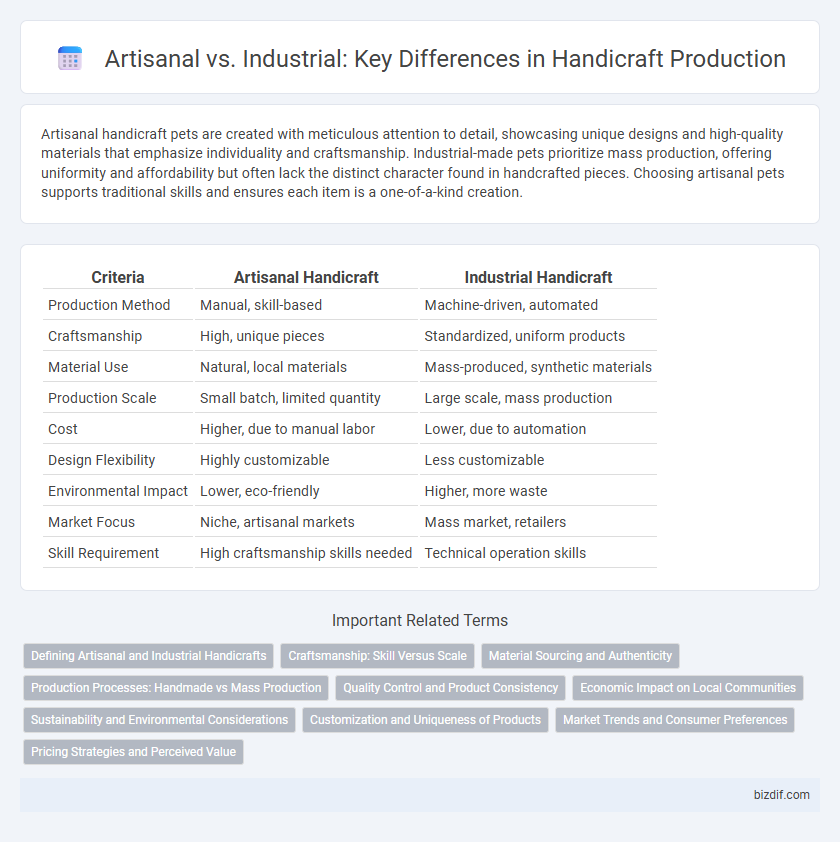Artisanal handicraft pets are created with meticulous attention to detail, showcasing unique designs and high-quality materials that emphasize individuality and craftsmanship. Industrial-made pets prioritize mass production, offering uniformity and affordability but often lack the distinct character found in handcrafted pieces. Choosing artisanal pets supports traditional skills and ensures each item is a one-of-a-kind creation.
Table of Comparison
| Criteria | Artisanal Handicraft | Industrial Handicraft |
|---|---|---|
| Production Method | Manual, skill-based | Machine-driven, automated |
| Craftsmanship | High, unique pieces | Standardized, uniform products |
| Material Use | Natural, local materials | Mass-produced, synthetic materials |
| Production Scale | Small batch, limited quantity | Large scale, mass production |
| Cost | Higher, due to manual labor | Lower, due to automation |
| Design Flexibility | Highly customizable | Less customizable |
| Environmental Impact | Lower, eco-friendly | Higher, more waste |
| Market Focus | Niche, artisanal markets | Mass market, retailers |
| Skill Requirement | High craftsmanship skills needed | Technical operation skills |
Defining Artisanal and Industrial Handicrafts
Artisanal handicrafts are defined by their creation through traditional, manual techniques, often reflecting cultural heritage and individual craftsmanship, while industrial handicrafts rely on mechanized processes that emphasize mass production and uniformity. Artisanal products usually exhibit unique characteristics and variations due to the handcrafted nature, contrasting with the standardized, repetitive output typical of industrial manufacturing. The distinction lies in the scale, tools, and methods employed, impacting both the value perception and market positioning of the handicrafts.
Craftsmanship: Skill Versus Scale
Artisanal craftsmanship emphasizes meticulous hand skills, unique techniques, and personalized attention to detail that machines cannot replicate, resulting in high-quality, one-of-a-kind handicraft products. Industrial production prioritizes scale, efficiency, and uniformity, often sacrificing the nuanced skill and artistry inherent in handmade items for mass-market accessibility. The value of artisanal handicraft lies in its authenticity and the skilled labor that transforms raw materials into culturally rich, individually crafted pieces.
Material Sourcing and Authenticity
Artisanal handicrafts prioritize sourcing natural, locally obtained materials, ensuring authenticity and supporting sustainable practices. Industrial production often relies on synthetic or mass-produced materials, which can compromise the uniqueness and cultural integrity of the final product. The emphasis on genuine, high-quality raw materials distinguishes artisanal pieces in terms of craftsmanship and cultural value.
Production Processes: Handmade vs Mass Production
Artisanal production emphasizes meticulous handmade techniques, where each item is crafted individually, reflecting unique craftsmanship and cultural heritage. In contrast, industrial production relies on automated machinery and assembly lines, enabling mass production with consistent quality and efficiency but less personalization. Handmade processes often result in limited quantities and higher value per piece, while mass production prioritizes volume and cost-effectiveness.
Quality Control and Product Consistency
Artisanal handicrafts emphasize meticulous quality control through skilled manual techniques, resulting in unique, high-quality products with subtle variations. Industrial production employs standardized processes and automated machinery to ensure consistent product output, minimizing defects and maintaining uniformity across large batches. The trade-off between artisanal uniqueness and industrial consistency defines quality control strategies in handicraft manufacturing.
Economic Impact on Local Communities
Artisanal handicrafts generate significant economic impact on local communities by supporting small-scale producers and preserving traditional skills, which fosters cultural heritage and sustainable livelihoods. In contrast, industrial production often centralizes manufacturing, limiting local employment opportunities and reducing community-based economic growth. Promoting artisanal crafts enhances local income diversification and resilience against global market volatility.
Sustainability and Environmental Considerations
Artisanal handicraft emphasizes sustainable practices by utilizing natural, locally sourced materials and minimizing waste through traditional techniques, reducing environmental impact compared to mass-produced industrial goods. Industrial production often relies on synthetic materials and energy-intensive processes, leading to higher carbon footprints and resource depletion. Supporting artisanal craftsmanship promotes environmental conservation and fosters eco-friendly consumer choices.
Customization and Uniqueness of Products
Artisanal handicrafts emphasize customization and uniqueness by allowing skilled artisans to create personalized and one-of-a-kind products tailored to individual preferences. Industrial production prioritizes mass manufacturing, resulting in uniform items with limited customization options and diminished uniqueness. The distinctiveness of artisanal products often reflects cultural heritage, craftsmanship, and personal artistic expression not found in industrial goods.
Market Trends and Consumer Preferences
Artisanal handicrafts emphasize unique, handmade products that appeal to consumers seeking authenticity and cultural heritage, driving a growing market trend favoring personalized and sustainable goods. In contrast, industrial handicraft production offers mass-produced items at lower costs, catering to broader markets prioritizing affordability and availability. Current consumer preferences increasingly favor artisanal products due to rising awareness of ethical sourcing and the desire for exclusive, high-quality craftsmanship.
Pricing Strategies and Perceived Value
Artisanal handicrafts command premium pricing through unique, handcrafted quality and limited production, enhancing perceived value among discerning consumers. Industrially produced goods leverage economies of scale to offer competitive pricing but often face lower perceived value due to mass production. Pricing strategies in artisanal markets focus on storytelling and authenticity, driving emotional connections that justify higher price points compared to industrial counterparts.
Artisanal vs Industrial Infographic

 bizdif.com
bizdif.com